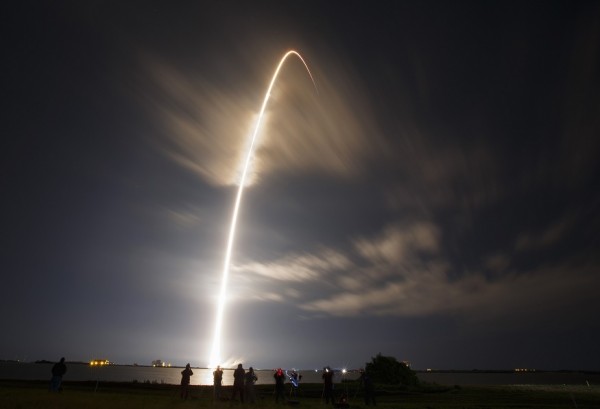SpaceX Falcon 9 Rocket Destroyed on Landing
| Ana Verayo | | Jan 11, 2015 08:04 AM EST |
(Photo : Reuters) The unmanned Falcon 9 rocket launched by SpaceX on a cargo resupply mission to the International Space Station on January 10, 2015.
A SpaceX Falcon 9 rocket carrying a cargo capsule was successfully launched to the International Space Station on Saturday. It failed on its first attempt to land on a floating ocean platform, however.
According to Elon Musk, CEO and founder of SpaceX, the rocket made it to the drone spaceport ship but landed hard. He said in a tweet it was, close, but no cigar this time.
Like Us on Facebook
Musk also revealed the returning rocket apparently ran out of the hydraulic fluid needed to steer its fins. He said the next vehicle will have 50 percent more hydraulic fluid.
Space Exploration Technologies or SpaceX has been developing a reusable rocket that can be refurbished and reflown, cutting down on launch costs. NASA currently reuses twin solid rocket boosters from the space shuttle missions it recovers from the ocean when they land via parachutes. This system is too expensive.
SpaceX's solution to cut costs is to fly its rockets back to the launch pad. The recent test marks the first time a Falcon 9 rocket attempted to land on a platform floating in the ocean.
Apart from four landing legs, the rocket also has four grid fins to stabilize the booster upon its descent. Saturday's launch sent a Dragon cargo ship to the ISS. The cargo is expected to arrive on Monday.
After a delayed launch last Tuesday, the rocket finally blasted off from the Cape Canaveral Air Force Station in Florida where it discarded a 14-storey tall first stage booster that landed on its target floating platform some 200 miles from the Florida coast but exploded into pieces.
The Dragon capsule is carrying 5,100 pounds of food and scientific supplies and equipment. This launch was the fifth of 12 planned station resupply missions by SpaceX provided under a US $1.6 billion contract with NASA.
TagsSpaceX Finally Sends Food and Cargo to Space Station; Rocket Explodes Upon Landing Back to Earth, SpaceX, Elon Musk, NASA, ISS, spacex landing launch rocket explodes fails ISS cargo, falcon 9 rocket
©2015 Chinatopix All rights reserved. Do not reproduce without permission
EDITOR'S PICKS
-

Did the Trump administration just announce plans for a trade war with ‘hostile’ China and Russia?
-

US Senate passes Taiwan travel bill slammed by China
-

As Yan Sihong’s family grieves, here are other Chinese students who went missing abroad. Some have never been found
-

Beijing blasts Western critics who ‘smear China’ with the term sharp power
-

China Envoy Seeks to Defuse Tensions With U.S. as a Trade War Brews
-

Singapore's Deputy PM Provides Bitcoin Vote of Confidence Amid China's Blanket Bans
-

China warns investors over risks in overseas virtual currency trading
-

Chinese government most trustworthy: survey
-

Kashima Antlers On Course For Back-To-Back Titles
MOST POPULAR
LATEST NEWS
Zhou Yongkang: China's Former Security Chief Sentenced to Life in Prison

China's former Chief of the Ministry of Public Security, Zhou Yongkang, has been given a life sentence after he was found guilty of abusing his office, bribery and deliberately ... Full Article
TRENDING STORY

China Pork Prices Expected to Stabilize As The Supplies Recover

Elephone P9000 Smartphone is now on Sale on Amazon India

There's a Big Chance Cliffhangers Won't Still Be Resolved When Grey's Anatomy Season 13 Returns

Supreme Court Ruled on Samsung vs Apple Dispute for Patent Infringement

Microsoft Surface Pro 5 Rumors and Release Date: What is the Latest?










